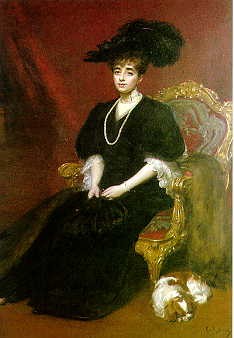From Christie's:
The story of ‘Boni’ de Castellane and Anna Gould is well known — a tale of Old World taste and New World money befitting a novel by Henry James or Edith Wharton. After marrying the American heiress in New York in 1895, the dapper French count wasted no time relieving his wife of her fortune — not least by commissioning a Grand Trianon-style ‘Palais Rose’ in Paris and persuading her to buy the Château du Marais, an elegant lakefront property in Essonne by a master of Louis XVI architecture, Jean-Benoît-Vincent Barré.
‘I fell in love with Le Marais,’ said Anna, as she and Boni set about restoring the château to its former glory and raising their five children at the same time. Anna soon grew tired of her husband’s spending and affairs, however, and in 1906, she divorced him, marrying his cousin, Hélie de Talleyrand-Périgord, the Duke of Sagan, and having two more children with him.
While Boni wrote his memoir, The Art of Being Poor, the Duke and Duchess refurbished the château, filling it with yet more beautiful things. And after her parents died, their daughter Violette kept it on, entertaining a constant stream of visitors among the 18th-century paintings, furniture, chandeliers and Meissen porcelain. Two decades after Violette’s death, the château has been split between the families of her two daughters, and its contents divided for sale. These include such beautiful and storied items as a set of Louis XVI gilt-walnut seat furniture crafted by Georges Jacob (1739–1814), supplier to Marie Antoinette, or a screen fashioned from four late-17th century panels, probably from Beauvais, the historic tapestry manufactory founded under Louis XIV.
‘There have been several sales of the collection of Boni de Castellane and Anna Gould, one at Christie’s in 2017,’ says Lionel Gosset, Head of Collections at Christie’s Paris. ‘This one is probably the last.’ (Read more.)
From France-Amérique:
Everything could have been perfect between Anna Gould and her husband, Marie Ernest Paul Boniface “Boni” de Castellane. She dreamed of a noble title; he was a count and member of one of the oldest French aristocratic families. She was barely over 18; he was 28 and had already mastered the art of being a gentleman. She was rich and had excellent taste; unfortunately, Boni de Castellane was warts and all – and not much else!
The count enjoyed telling the press that he had visited the United States in 1895 to “discover the country” and, as an experienced sportsman, “to hunt.” He failed to specify exactly what type of game, but his search stopped in Lakewood, New Jersey, where he attended a party at George Gould’s home. This is where he locked eyes with his sister, Anna, whom he had previously met in Paris. The pair met up once, twice, and then traveled to Canada with her family, smiling coyly all the way. Eventually, to everyone’s surprise, Boni de Castellane declared his love. Yet no one had predicted their affair. The young Anna fully exploited the right to ugliness enjoyed by the rich. She was smaller than average, with an asymmetrical face, frizzy hair, a dull, dark stare, a large nose, and even walked with a slight limp. Even in the most elegant finery, she looked like a little monkey dressed as a princess.
When by her side, Boni’s natural distinction was all the more blatant. With a porcelain complexion, lavender-blue eyes, wavy blonde hair, a strong, arched back, a curled moustache, and impeccably manicured fingernails, he was the archetype of the Parisian dandy. It is likely that the young Anna was impressed by this man, who spent more time meticulously tending to his appearance than all the Gould family put together. What’s more, she had desperately wanted to marry at any cost for more than a year. At any cost? The count’s ears pricked up! With the agreement of the two families, the square peg and the round hole were wed on March 4, 1895, in New York City. Two days later, the couple set off for Europe.
[...]
Worthy of the grandest monarchs of the Ancien Régime, the count and countess de Castallane’s lifestyle was so lavish that they burned through 7.7 million dollars (251 million today) in the first five years of their marriage. The international press went wild and American psychiatrists began studying Boni’s personality. They even came up with a name for his behavior: coenaesthesis. The Goulds tried to regulate the couple’s spending, although without attempting to understand it. In 1900, Anna was placed under the guardianship of her brother, George, and her debts (she had dipped extensively into her capital, despite the fact that she was supposed to live on the interest alone) were spread out over several years of repayments.
Boni was outraged at being reduced to live on an annual allowance of 300,000 dollars (less than 10 million today). Meanwhile, Anna had grown tired of her spendthrift, quarrelsome, vain husband. Above all, she hated his numerous affairs and the rumors he spread about her. When leading a visit around their first apartment, Boni found it amusing to describe their bedroom as the “expiatory chapel,” and the “other side of the coin.” Encouraged by her family, she finally divorced in 1906 and took her revenge in 1908 by marrying Boni’s cousin, Duke Hélie de Talleyrand-Périgord, with whom she had two children. Boni, ever the comedian, became an antiques expert and wrote his memoirs under the title The Art of Being Poor! (Read more.)
 |
| Anna Gould |
Share


















No comments:
Post a Comment